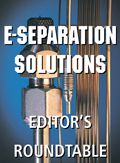Ask the Editor: nanoLC
Generally, nanoLC columns with internal diameters less than 0.1 mm are mainly used in proteomic studies where sample amount is often limited and high sensitivity is required, usually via mass spectrometry (MS).
For Ron Majors: I have with great pleasure read your “Column Watch” installment “Current Trends in HPLC Column Usage” from the June 2007 issue of LCGC (1) as well as the two-part “Directions in Discovery” column series “A NanoLC-MS Primer for Expression Proteomics” from the March and June 2006 issues of LCGC (2,3). Do you have any more information related to the trend of usage of nanoLC columns?
LCGC's "Column Watch"" target="_blank">"Column Watch" columnist Ron Majors provides us with the following answer:
Ron Majors: The “Current Trends in HPLC Column Usage” installment of “Column Watch” (1) surveyed the entire field of liquid chromatography (LC) columns from many different aspects. In particular, nanoLC was not a particular focus but was treated as another dimension of column. Several of the questions asked in our survey were related to nanoLC and capillary LC (somewhat lumped together). Generally, nanoLC columns with internal diameters less than 0.1 mm are mainly used in proteomic studies where sample amount is often limited and high sensitivity is required, usually via mass spectrometry (MS). Small-bore columns of capillary and nano dimensions shine when small mass requires high sensitivity. In most regular high performance liquid chromatography (HPLC) applications, this is not the case. Most workers successfully using nanoLC columns generally use a nanoLC system. Trying to adapt a regular LC system designed for 4.6-mm i.d. columns to the small flow rates required in nanoLC (in the range of several hundred nanoliters per minute) is quite difficult. From Table I in my column installment (1), you can see that for every 2.9 conventional LC systems there are approximately 0.26 nano instruments for a ratio of about 10:1. For every 5 conventional columns as one might expect about 0.6 nano columns are used (roughly 10:1), probably by the same instrument owners. When I asked the question about future interests, about 12% (1 out of 8) of the respondents showed a future interest in nano columns. So that might tell you that there is a slight interest compared with today’s 10% use, but not a significant number were sufficiently interested in nanoLC columns. Some of the driving forces for reduction in LC column dimensions haven’t been strong enough to convert conventional LC users to capillary and nano columns. One of them, solvent reduction (due to much smaller flow rate requirements) has never materialized as a driver. The column purchase prices are not much lower than conventional columns. Conventional detectors such as UV and refractive index detectors have adapted to nano dimensions, and not everybody can afford (or actually needs) a mass spectrometer.
Based on the cross-section area of columns with smaller internal diameters - that is, nanoLC and capillary columns - one has to be quite careful in introducing samples. Most of the time proteomic peptide samples are obtained by tryptic digest of a protein, and occasionally proteins themselves are chromatographed. The last step before injection is a filtration or centrifugation step - mainly to remove particulates because not only do the columns have small internal diameters but the tubing leading to them is also very small and can be blocked. Sometimes, the amount of sample is so small that filtration is impossible. Most chemists who perform nanoLCâMS separations pack their own columns, mainly for cost but also for convenience. In fact, there is even a commercial apparatus that one can purchase for a couple thousand dollars that is made for nano column packing. It takes 10â15 min to pack a 15 cm *X* 0.075 mm fused-silica column. Because the self-packed columns aren’t packed at a very high pressure, their life is somewhat limited and they allow nowhere near the 1000+ injections that one can achieve with conventional 4.6-mm i.d. analytical columns. Often, users place in-line filters before the nanoLC columns to help protect them and extend their life.Another approach to nanoLC is Agilent’s LC Chip format. The chip is packed with different packing types (for example, C18, graphitized carbon, and so forth) and has the dimension of 40 mm *X* 0.050 mm. The electrospray nozzle is part of the chip and is optimally positioned in the mass spectrometer inlet automatically. With this format, our chemists have been able to perform over 300 injections of a clean tryptic digest sample. Of course, if one injects dirty samples, the chip tubing or nano column can plug also just like any nanoLC column.A report from M. Noga and colleagues on troubleshooting nanoLC columns also might be of interest (4).
Reference
(1) R.E. Majors, LCGC 25(6), 532â544 (2007).
(2) T. Wehr and C. McEathron, LCGC 24(3), 286â294 (2006).
(3) C. McEathron and T. Wehr, LCGC 24(6), 492â497 (2006).
(4) M. Noga, F. Sucharski, P. Suder, and J. Silberring, J. Sep. Sci. 30, 2179â2189 (2007).
Questions?
LCGC technical editor Steve Brown will answer your technical questions. Each month, one question will be selected to appear in this space, so we welcome your submissions. Please send all questions to the attention of "Ask the Editor" at lcgcedit@lcgcmag.com. We look forward to hearing from you.
LCGC’s Year in Review: Highlights in Liquid Chromatography
December 20th 2024This collection of technical articles, interviews, and news pieces delves into the latest innovations in LC methods, including advance in high performance liquid chromatography (HPLC), ultrahigh-pressure liquid chromatography (UHPLC), liquid chromatography–mass spectrometry (LC–MS), and multidimensional LC.
Using LC-MS/MS to Measure Testosterone in Dried Blood Spots
December 19th 2024Testosterone measurements are typically performed using serum or plasma, but this presents several logistical challenges, especially for sample collection, storage, and transport. In a recently published article, Yehudah Gruenstein of the University of Miami explored key insights gained from dried blood spot assay validation for testosterone measurement.
